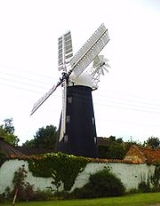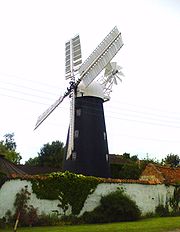
Mount Pleasant Mill
Encyclopedia

Windmill
A windmill is a machine which converts the energy of wind into rotational energy by means of vanes called sails or blades. Originally windmills were developed for milling grain for food production. In the course of history the windmill was adapted to many other industrial uses. An important...
north of Kirton-in-Lindsey
Kirton in Lindsey
Kirton-in-Lindsey, also abbreviated to Kirton Lindsey, is a small town and civil parish in North Lincolnshire, England.-Geography:It is south of Scunthorpe, near the A15 road, and has a total resident population of 2,694....
on the North Cliff Road in North Lincolnshire
North Lincolnshire
North Lincolnshire is a unitary authority area in the region of Yorkshire and the Humber in England. For ceremonial purposes it is part of Lincolnshire....
in the east of England (Yorkshire and the Humber
Yorkshire and the Humber
Yorkshire and the Humber is one of the nine regions of England and formally one of the government office regions. It covers most of the historic county of Yorkshire, along with the part of northern Lincolnshire that was, from 1974 to 1996, within the former shire county of Humberside. The...
).
Construction
It was built in 1875 for miller Edric Lansdall as a four-patent-sailed, slightly tapering four-storeyed tarred tower millTower mill
A tower mill is a type of windmill which consists of a brick or stone tower, on top of which sits a roof or cap which can be turned to bring the sails into the wind....
with onion-shaped cap and fantail
Windmill fantail
A Fantail is a small windmill mounted at right angles to the sails, at the rear of the windmill, and which turns the cap automatically to bring it into the wind. The fantail was patented in 1745 by Edmund Lee, a blacksmith working at Brockmill Forge near Wigan, England, and perfected on mills...
on top of the remaining roundhouse of a previously erected post-mill. The junction between the former roundhouse wall of hand-made bricks and the newly superimposed tower made of machine-moulded bricks is almost indistinguishable. On the second floor, the stone floor, originally three pairs of millstones (two pairs of peak stones (grey stones or greys) and one pair of quartzite
Quartzite
Quartzite is a hard metamorphic rock which was originally sandstone. Sandstone is converted into quartzite through heating and pressure usually related to tectonic compression within orogenic belts. Pure quartzite is usually white to gray, though quartzites often occur in various shades of pink...
(French stone)) were driven, of which only one grey pair remained. This peak stone is cut from rock millstone grit
Millstone Grit
Millstone Grit is the name given to any of a number of coarse-grained sandstones of Carboniferous age which occur in the Northern England. The name derives from its use in earlier times as a source of millstones for use principally in watermills...
quarried in the Peak District
Peak District
The Peak District is an upland area in central and northern England, lying mainly in northern Derbyshire, but also covering parts of Cheshire, Greater Manchester, Staffordshire, and South and West Yorkshire....
of southwest Yorkshire
Yorkshire
Yorkshire is a historic county of northern England and the largest in the United Kingdom. Because of its great size in comparison to other English counties, functions have been increasingly undertaken over time by its subdivisions, which have also been subject to periodic reform...
and northeast Derbyshire
Derbyshire
Derbyshire is a county in the East Midlands of England. A substantial portion of the Peak District National Park lies within Derbyshire. The northern part of Derbyshire overlaps with the Pennines, a famous chain of hills and mountains. The county contains within its boundary of approx...
, England.
The mill has had a namesake windmill in Stockton-on-Tees
Stockton-on-Tees
Stockton-on-Tees is a market town in north east England. It is the major settlement in the unitary authority and borough of Stockton-on-Tees. For ceremonial purposes, the borough is split between County Durham and North Yorkshire as it also incorporates a number of smaller towns including...
, built around 1790 as a 8-storeyed four-sailed stage-windmill of ca. 80 ft height in reverse colours (white painted tower with black onion-shaped cap) and demolished around the late 1920s.
History
Mount Pleasant Mill worked by wind until 1933 and by a diesel single cylinder Crossley engine until 1973. Fred Banks, who ran it then, also owned Alford WindmillAlford Windmill
Alford Windmill is a five-sailed windmill in Alford, Lincolnshire and the only surviving windmill out of four. Today the windmill has been restored to working order, and grinds grain to organic flour...
. It is the only windmill in the area beside Heapham Mill with original and unrestored equipment and machinery of the 1920s and 1930s. The original cap with the oak cap frame is still in place. The original windshaft, wallower, upright shaft and great spur wheel are made of cast iron
Cast iron
Cast iron is derived from pig iron, and while it usually refers to gray iron, it also identifies a large group of ferrous alloys which solidify with a eutectic. The color of a fractured surface can be used to identify an alloy. White cast iron is named after its white surface when fractured, due...
, as are the tooth ring of the wooden brakewheel with its timber
Timber
Timber may refer to:* Timber, a term common in the United Kingdom and Australia for wood materials * Timber, Oregon, an unincorporated community in the U.S...
clasp arm construction and wooden brake, all installed in the 1930s. A refinement to the mill is the elevator to replace the old sack hoist
Hoist (device)
A hoist is a device used for lifting or lowering a load by means of a drum or lift-wheel around which rope or chain wraps. It may be manually operated, electrically or pneumatically driven and may use chain, fiber or wire rope as its lifting medium. The load is attached to the hoist by means of a...
which worked off the underside of the wallower by a friction ring, and the elevator to feed the first floor bin (3rd floor) for the hurst frame. This is a massive timber frame supporting the transfer gearing and heavy mill stones casings, helping to reduce the vibration of the turning mill stones and their wheels (stone nuts). It is a separate structure inside the mill tower thus reducing the transfer of vibrations and noise into the building itself.
The mill was restored in 1991 and is a commercially working flour mill, making organic flour which is sold to the public. There is a tea room for visitors.

